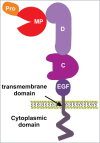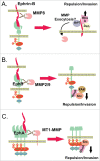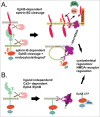The role of proteases in regulating Eph/ephrin signaling
- PMID: 25482632
- PMCID: PMC4594553
- DOI: 10.4161/19336918.2014.970026
The role of proteases in regulating Eph/ephrin signaling
Abstract
Proteases regulate a myriad of cell functions, both in normal and disease states. In addition to protein turnover, they regulate a range of signaling processes, including those mediated by Eph receptors and their ephrin ligands. A variety of proteases is reported to directly cleave Ephs and/or ephrins under different conditions, to promote receptor and/or ligand shedding, and regulate receptor/ligand internalisation and signaling. They also cleave other adhesion proteins in response to Eph-ephrin interactions, to indirectly facilitate Eph-mediated functions. Proteases thus contribute to Eph/ephrin mediated changes in cell-cell and cell-matrix interactions, in cell morphology and in cell migration and invasion, in a manner which appears to be tightly regulated by, and co-ordinated with, Eph signaling. This review summarizes the current literature describing the function and regulation of protease activities during Eph/ephrin-mediated cell signaling.
Keywords: AD, Alzheimer's disease; ADAM, a disintegrin and metalloprotease; APP, Amyloid precursor protein; Arf1, ADP rybosylation factor 1; BACE, β-site APP cleaving enzyme; CAM, cell adhesion molecules; CTF, cytoplasmic fragment; CNC, cranial neural crest; ECM,; ADAM; Eph receptor tyrosine kinase; MMP; ephrin signaling; protease; γ-secretase.
Figures




Similar articles
-
Eph receptor and ephrin function in breast, gut, and skin epithelia.Cell Adh Migr. 2014;8(4):327-38. doi: 10.4161/19336918.2014.970012. Cell Adh Migr. 2014. PMID: 25482622 Free PMC article. Review.
-
Homotypic receptor-receptor interactions regulating Eph signaling.Cell Adh Migr. 2014;8(4):360-5. doi: 10.4161/19336918.2014.971684. Cell Adh Migr. 2014. PMID: 25530219 Free PMC article. Review.
-
Eph/ephrin signalling during development.Development. 2012 Nov;139(22):4105-9. doi: 10.1242/dev.074997. Development. 2012. PMID: 23093422 Review.
-
Eph/ephrin signaling in morphogenesis, neural development and plasticity.Curr Opin Cell Biol. 2004 Oct;16(5):580-9. doi: 10.1016/j.ceb.2004.07.002. Curr Opin Cell Biol. 2004. PMID: 15363810 Review.
-
The Eph/Ephrin family in cancer metastasis: communication at the service of invasion.Cancer Metastasis Rev. 2012 Jun;31(1-2):353-73. doi: 10.1007/s10555-012-9352-1. Cancer Metastasis Rev. 2012. PMID: 22549394 Review.
Cited by
-
Preferential Antibody and Drug Conjugate Targeting of the ADAM10 Metalloprotease in Tumours.Cancers (Basel). 2022 Jun 28;14(13):3171. doi: 10.3390/cancers14133171. Cancers (Basel). 2022. PMID: 35804938 Free PMC article.
-
Missense mutations of the ephrin receptor EPHA1 associated with Alzheimer's disease disrupt receptor signaling functions.J Biol Chem. 2025 Feb;301(2):108099. doi: 10.1016/j.jbc.2024.108099. Epub 2024 Dec 18. J Biol Chem. 2025. PMID: 39706267 Free PMC article.
-
Emerging Roles for Eph Receptors and Ephrin Ligands in Immunity.Front Immunol. 2019 Jul 4;10:1473. doi: 10.3389/fimmu.2019.01473. eCollection 2019. Front Immunol. 2019. PMID: 31333644 Free PMC article. Review.
-
ADAM proteases: Emerging role and targeting of the non-catalytic domains.Cancer Lett. 2019 Dec 28;467:50-57. doi: 10.1016/j.canlet.2019.10.003. Epub 2019 Oct 5. Cancer Lett. 2019. PMID: 31593799 Free PMC article. Review.
-
High-quality genome assemblies provide clues on the evolutionary advantage of blue peafowl over green peafowl.Heliyon. 2023 Jul 22;9(8):e18571. doi: 10.1016/j.heliyon.2023.e18571. eCollection 2023 Aug. Heliyon. 2023. PMID: 37576271 Free PMC article.
References
-
- Serim S, Haedke U, Verhelst SHL. Activity-based probes for the study of proteases: recent advances and developments. ChemMedChem 2012; 7:1146-59; PMID:22431376; http://dx.doi.org/10.1002/cmdc.201200057 - DOI - PubMed
-
- Drag M, Salvesen GS. Emerging principles in protease-based drug discovery. Nat Rev Drug Discov 2010; 9:690-701; PMID:20811381; http://dx.doi.org/10.1038/nrd3053 - DOI - PMC - PubMed
-
- Turk B. Targeting proteases: successes, failures and future prospects. Nat Rev Drug Dis 2006; 5:785-99; PMID:16955069; http://dx.doi.org/10.1038/nrd2092 - DOI - PubMed
-
- Lopez-Otin C, Bond JS. Proteases: multifunctional enzymes in life and disease. J Biol Chem 2008; 283:30433-7; PMID:18650443; http://dx.doi.org/10.1074/jbc.R800035200 - DOI - PMC - PubMed
-
- Overall CM, Blobel CP. In search of partners: linking extracellular proteases to substrates. Nat Rev Mol Cell Biol 2007; 8:245-57; PMID:17299501; http://dx.doi.org/10.1038/nrm2120 - DOI - PubMed
Publication types
MeSH terms
Substances
LinkOut - more resources
Full Text Sources
Other Literature Sources
Miscellaneous
